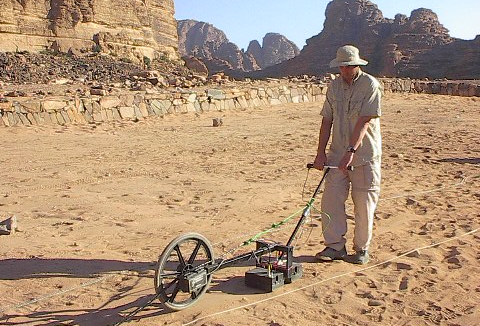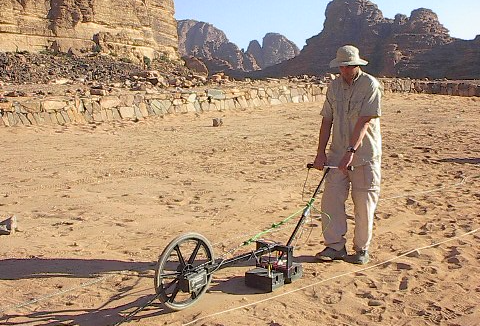Radar Resolution Gets a Boost
The radar devices used to spot landmines have trouble distinguishing features at the depths at which these objects are typically buried, which can lead to false positives and thus wasted time. Now researchers have demonstrated a proof of concept for a radar method that can resolve smaller objects at greater depths than was previously possible [1]. The researchers say that their technique could allow detection of landmines buried a few meters underground, far deeper than the few centimeters accessible with current technology. Archeologists could also use the new method to find buried artifacts.
A radar system sends out a series of short radio-wave pulses that may encounter an object and reflect back to the device. The device uses the reflected waves to determine the object’s size and distance. When there are two objects in the pulses’ path, the device can resolve both objects if it detects two distinct peaks in the reflected radio waves.
To increase a radar’s power to resolve objects that are close to each other, the pulses can be shortened. Reducing a pulse’s length requires increasing its bandwidth, which is the spread of frequencies that add up to make the pulse. Typically, pulses are shortened by adding in higher-frequency waves, but adding those frequencies has a downside. “Almost every material medium becomes more opaque with increasing frequency,” says John Howell, a radar scientist at Chapman University in California. This increasing opaqueness limits the depths to which one can probe when including high frequencies. So in order to increase the sensitivity at longer distances, radar users must employ longer pulses and thus sacrifice resolution.
To beat this limitation, Howell and his colleagues designed a radar waveform that looks like a series of zigzags, with a triangular peak and trough and an additional peak and trough that are truncated so that they include flat segments. The sloped segments are highly sensitive to interference between different reflected waves, whereas the flat sections are insensitive to such interference.
The team tested this waveform by sending it through a coaxial cable arranged to produce two versions of the 200-nanosecond-long signal at the far end: the direct version and a version delayed by several nanoseconds. An oscilloscope detected the interference of the two signals, which represented the reflections expected from two neighboring objects.
The combined signal contained some sections that were substantially changed and others that were unchanged. These “no change” regions acted as reference points that allowed the researchers to detect changes that would have occurred over distances shorter than the pulse length and that were induced by interference between the two reflections. Using this information, the team inferred separation distances between the two virtual objects that were tens of thousands of times shorter than would otherwise be possible.
This proof of concept indicates that the method should provide significant improvements, Howell says. “Radar with sufficient resolution to see a mine can only probe a few centimeters into the ground. Now we can obtain subcentimeter resolution and probe many meters underground.” This improvement could also enable archeologists to find tiny, buried objects—currently, they can only spot large walls or voids. It could also help oceanographers map the ocean floor, which is not possible with current radar systems.
The resolution increase that Howell and his colleagues report beats previous ones “by orders of magnitude, which is impressive and exciting,” says Stefan Frick, a quantum physicist who works on quantum radar at the University of Innsbruck, Austria. Thomas Fromenteze, a specialist in radar technologies at the University of Limoges, France, comes to the same conclusion. “Resolution limits represent a considerable hardware limitation in radar imaging,” he says, and the new work could benefit the development of super-resolution methods.
However, both Frick and Fromenteze question whether the new technique will work under real-world conditions. Frick also notes that while this new technique improves vertical resolution, it doesn’t affect sensitivity. “Such a system cannot detect objects that a conventional radar system could not detect,” he says.
Chapman University team member Andrew Jordan acknowledges these concerns. The test is the first in a series of experiments needed to prove the concept, he says. The team is currently working to demonstrate the technique with waves propagating through air. In response to Frick’s concern about sensitivity, Jordan notes that, for landmine detection, current systems cannot distinguish rocks from explosive charges. And while the new technique may not find additional objects, its improved vertical resolution should provide fine details of the object along with its depth, allowing users to solve the rock-or-landmine problem.
–Katherine Wright
Katherine Wright is the Deputy Editor of Physics Magazine.
References
- J. C. Howell et al., “Super interferometric range resolution,” Phys. Rev. Lett. 131, 053803 (2023).






